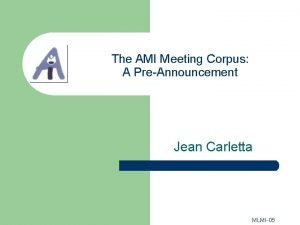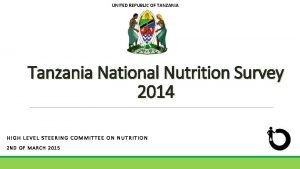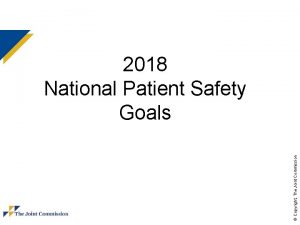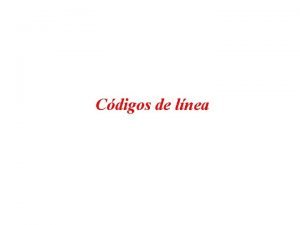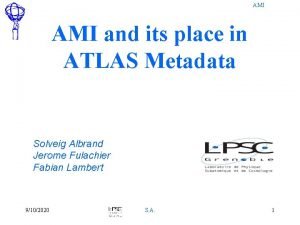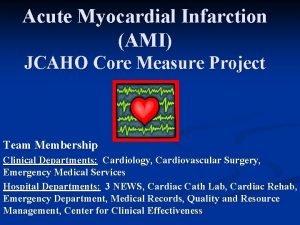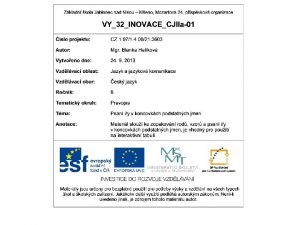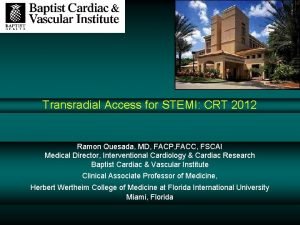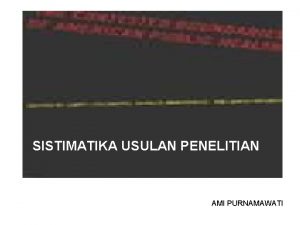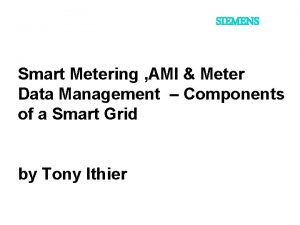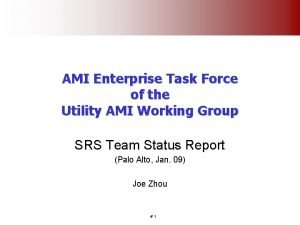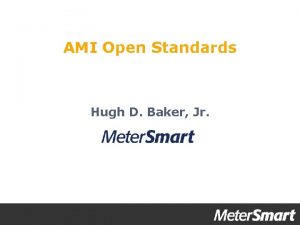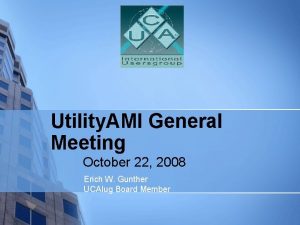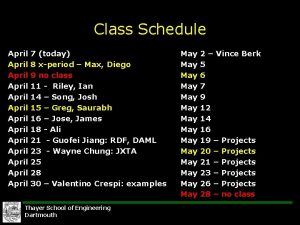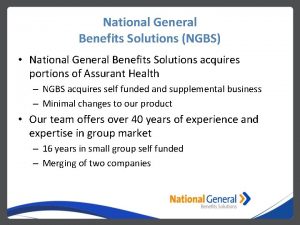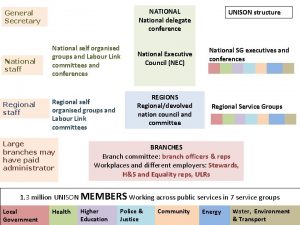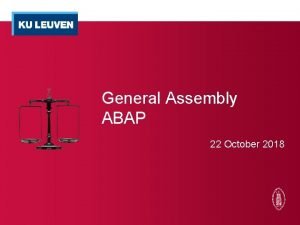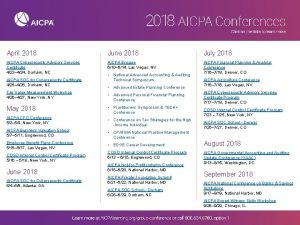AMI General Meeting April 19 2018 Hartefeld National





































- Slides: 37

AMI General Meeting April 19, 2018 Hartefeld National Golf Club Avondale, PA Walking-Working Surfaces and Fall protection Standards Jim Harrity Compliance Assistance Specialist, Philadelphia Area Office

Disclaimer This information is intended to assist employers, workers, and others as they strive to improve workplace health and safety. While we attempt to thoroughly address specific topics, it is not possible to include discussion of everything necessary to ensure a healthy and safe working environment in a presentation of this nature. Thus, this information must be understood as a tool for addressing workplace hazards, rather than an exhaustive statement of an employer’s legal obligations, which are defined by statute, regulations, and standards. Likewise, to the extent that this information references practices or procedures that may enhance health or safety, but which are not required by a statute, regulation, or standard, it cannot, and does not, create additional legal obligations. Finally, over time, OSHA may modify rules and interpretations in light of new technology, information, or circumstances; to keep apprised of such developments, or to review information on a wide range of occupational safety and health topics, you can visit OSHA’s website at www. osha. gov. 2

Source: U. S. Department of Labor, Bureau of Labor Statistics, Census of Fatal Occupational Injuries

Purpose of the New Rule • To update the outdated subpart D • To increase consistency with OSHA’s construction standards • To set criteria requirements for personal fall protection equipment • To make the final rule easier to understand follow. • To give employers greater compliance flexibility. 4

Major Changes • Fall Protection Flexibility • Updated Scaffold Requirements • Phase-in of ladder safety systems or personal fall arrest systems on fixed ladders • Phase-out of “qualified climbers” on outdoor advertising structures • Rope descent systems • Adds training requirements • Adds requirements for personal fall protection equipment (final § 1910. 140) 5

Timeline • Most of the rule became effective January 17, 2017 • Ensuring exposed workers are trained on fall hazards (May 17, 2017), • Ensuring workers who use equipment covered by the final rule are trained (May 17, 2017), • Inspecting and certifying permanent anchorages for rope descent systems (November 20, 2017), • Installing ladder safety systems on new fixed ladders over 24 feet and on replacement ladders/ladder sections, including fixed ladders on outdoor advertising structures (November 19, 2018), • Ensuring existing fixed ladders over 24 feet, including those on outdoor advertising structures, are equipped with a cage, well, personal fall arrest system, or ladder safety system (November 19, 2018), and • Installing ladder safety system or personal fall arrest system on all fixed ladders over 24 feet (November 18, 2036). 6

Organization of Subpart D and Changes to Subpart I § 1910. 21 – Scope, Application and Definitions § 1910. 22 – General Requirements § 1910. 23 – Ladders § 1910. 24 – Stepbolts and Manhole Steps § 1910. 25 – Stairways § 1910. 26 – Dockboards

Organization of Subpart D and Changes to Subpart I § 1910. 27 – Scaffolds and Rope Descent Systems § 1910. 28 – Duty to Have Fall Protection § 1910. 29 – Fall Protection Systems Criteria and Practices § 1910. 30 –Training Requirements § 1910. 140 - PPE

§ 1910. 21 Scope and definitions • Consolidates definitions into one section • Adds new definitions to provide clarity 9

New Definitions 1910. 21 For instance: • • • Combination ladder. Designated Areas. Ladder safety system. Low-Slope Roof. Personal fall protection system. Positioning Systems. Qualified describes a person. Rope descent system. Travel restraint system. Warning Line 10

§ 1910. 22 Final § 1910. 22 revises and updates the existing requirements that apply to surfaces in general industry. These provisions address: • Surface conditions and housekeeping (paragraph (a)); • Application of loads on walking-working surfaces (paragraph (b)); • Access to and egress from walking-working surfaces (paragraph (c)); and • Inspection, maintenance, and repair of walking-working surfaces (paragraph (d)). 11

§ 1910. 22 – Walking-working surfaces are inspected, regularly and as necessary, and maintained in a safe condition; – Hazardous conditions on walking-working surfaces are corrected or repaired before an employee uses the walkingworking surface again. If the correction or repair cannot be made immediately, the hazard must be guarded to prevent employees from using the walking-working surface until the hazard is corrected or repaired; 12

§ 1910. 23 • Consolidates and simplifies rules into general requirements, portable ladders, fixed ladders, and mobile ladder stands • Requires inspection before use 13

§ 1910. 23 Ladders Final § 1910. 23 revises and consolidates into one section the existing ladder requirements in 1910. 25 (Portable wooden ladders) 1910. 26 (Portable metal ladders) 1910. 27 (Fixed ladders) 1910. 29 (Mobile ladder stands and scaffolds (tower)). Retains many of the existing requirements because OSHA believes they continue to provide an appropriate level of worker safety. 14

Ladders, Stairs and Ramps Angles for Stairs, Ramps, and Ladders Figure D-10 15

§ 1910. 25 Are installed at a slope of 50 to 70 degrees from the horizontal; Have open risers with a vertical rise between tread surfaces of 6. 5 to 12 inches Have minimum tread depth of 4 inches Have a minimum tread width of 18 inches 16

§ 1910. 24 • constructed of, or coated with, material that protects against corrosion • before January 17, 2017 is capable of supporting its maximum intended load • after January 17, 2017 is capable of supporting at least four times its maximum intended load 17

§ 1910. 24 after January 17, 2017 • constructed of, or coated with, material that protects against corrosion • Has a corrugated, knurled, dimpled, or other surface • Is inspected at the start of the work shift and maintained in accordance with § 1910. 22 18

§ 1910. 25 General requirements for stairways: • • Handrails, stair rail systems, and guardrail systems are provided in accordance with § 1910. 28 Vertical clearance above any stair tread to any overhead obstruction is at least 6 feet, 8 inches, as measured from the leading edge of the tread Stairs have uniform riser heights and tread depths between landings; Stairway landings and platforms are at least the width of the stair and at least 30” in depth, as measured in the direction of travel; 19

§ 1910. 25 20” for platforms before Jan 17, 2017; 22” for platforms after Jan. 17, 2017 Stairs installed prior to January 17, 2017. OSHA will deem those stairs in compliance if they meet the dimension requirements specified in Table D-1 20

§ 1910. 26 • Updates requirements for dockboards • Adds design and construction requirements to prevent equipment from going over the dockboard edge • Include, but are not limited to, bridge plates, dock plates, and dock levelers 21

§ 1910. 27 • Requires that employers using scaffolds follow the construction standard. 29 CFR part 1926, Subpart L (Scaffolds). 22

§ 1910. 27 • Adds provision allowing use of RDS, which codifies a 1991 OSHA memo allowing RDS • Requires certification of anchorages starting 1 year after final rule published- Nov. 20, 2017 • Requires RDS have separate fall arrest system 23

§ 1910. 28 • This section requires employers to provide protection for each employee exposed to fall and falling object hazards. Unless stated otherwise, the employer must ensure that all fall protection and falling object protection required by this section meet the criteria in § 1910. 29, except that personal fall protection systems required by this section meet the criteria of § 1910. 140. 24

§ 1910. 28 1. Unprotected sides and edges 2. Hoist areas 3. Holes 4. Dockboards 5. Runways and similar walkways 6. Dangerous Equipment 7. Openings 8. Repair Pits, Service Pits… (< than 10’) 9. Fixed Ladders (> 24’) 10. Outdoor advertising (billboards) 11. Stairways 12. Scaffold and rope descent systems 13. Work on low-slope roofs 14. Slaughtering facility platforms 15. Walking-working surfaces NOA 25

§ 1910. 29 Fall protection systems criteria Specifies design and installation requirements of each fall protection system available to employers including: a) b) c) d) e) f) General requirements Guardrail system Safety nets Designated areas Covers Handrail and Stair rails systems g) Cages and wells used with fixed ladders h) Outdoor advertising i) Ladder safety systems j) Personal fall protection systems k) Travel Restraint System l) Grab handles


NOT TO SCALE 15 fe Des ig Area nated et 6 fe et • Less than 6’ = system • 6’ – 15’ = system or designated area (if infrequent and temporary) • More than 15’ = system or designated area and work rule No fall protection, provided work is infrequent and temporary AND a work rule prohibiting employees from going w/in 15’ of edge

Distance From an Edge When work is performed less than 6 feet (1. 6 m) from the roof edge, the employer must ensure each employee is protected from falling by a guardrail system, safety net system, travel restraint system, or personal fall arrest system. When work is performed at least 6 feet (1. 6 m) but less than 15 feet (4. 6 m) from the roof edge, the employer must ensure each employee is protected from falling by using a guardrail system, safety net system, travel restraint system, or personal fall arrest system. The employer may use a designated area when performing work that is both infrequent and temporary. 29

Distance From an Edge • From the Preamble: • The term ‘‘infrequent, ’’ for purposes of the final rule, means that the task or job is performed only on occasion, when needed (e. g. , equipment breakdown), on an occasional basis, or at sporadic or irregular intervals. Infrequent tasks include work activities such as annual maintenance or servicing of equipment, monthly or quarterly replacement of batteries or HVAC filters, and responding to equipment outage or breakdown. In these instances, the frequency of exposure to fall hazards is very limited. • By contrast, tasks performed or repeated on a daily, routine or regular basis are not infrequent activities within the meaning of the final rule. Infrequent jobs also do not include those that workers perform as a primary or routine part of their job or repeatedly at various locations during a work shift. A task may be considered infrequent when it is performed once a month, once a year, or when needed. 30

§ 1910. 30 The employer must train each employee in at least the following topics: • The nature of the fall hazards in the work area and how to recognize them; • The procedures to be followed to minimize those hazards; • The correct procedures for installing, inspecting, operating, maintaining, and disassembling the personal fall protection systems that the employee uses; and • The correct use of personal fall protection systems and equipment, including, but not limited to, proper hook-up, anchoring, and tie-off techniques, and methods of equipment inspection and storage, as specified by the manufacturer. 31

§ 1910. 140 • Personal fall protection systems. • Scope and application. This section establishes performance, care, and use criteria for all personal fall protection systems. The employer must ensure that each personal fall protection system used to comply with this part must meet the requirements of this section. 32

§ 1910. 140 – Personal Protective Equipment (Personal Fall Protection Systems) • Adds definitions for personal fall protection systems • Adds new section on system and use criteria for: • Personal fall protection equipment (e. g. , lanyards, ropes, D-rings, harnesses) • Travel restraint systems • Personal fall arrest systems • Work positioning systems 33

Distance From an Edge • Low-slope roof means a roof that has a slope less than or equal to a ratio of 4 in 12 (vertical to horizontal). • Designated area means a distinct portion of a walkingworking surface delineated by a warning line in which employees may perform work without additional fall protection. • Warning line means a barrier erected to warn employees that they are approaching an unprotected side or edge, and which designates an area in which work may take place without the use of other means of fall protection. 34

Main Effective Dates • Rule overall: January 17, 2017 • Training: 6 months after publication • Building anchorages for RDS: 1 year after publication • Fixed ladder fall protection: 2 years after publication • Installation of ladder safety system on fixed ladders > 24’: 20 years after publication 35

WWW. OSHA. GOV • Walking-Working Surfaces and Fall Protection Rule Final Rule to Update General Industry Walking-Working Surfaces and Fall Protection Standards • Read the Rule in the Federal Register • Regulatory Text • Fact Sheet • Questions and Answers • Press Release https: //www. osha. gov/walking-working-surfaces/index. html

Thank You!
 Ami corpus
Ami corpus Que letra continua m v t m j
Que letra continua m v t m j Aua meeting 2018
Aua meeting 2018 Nrg oncology meeting 2016
Nrg oncology meeting 2016 Nrg virtual meeting
Nrg virtual meeting For todays meeting
For todays meeting Today meeting or today's meeting
Today meeting or today's meeting What is meeting and types of meeting
What is meeting and types of meeting What is meeting and types of meeting
What is meeting and types of meeting Tanzania national nutrition survey 2018
Tanzania national nutrition survey 2018 Tanzania national nutrition survey 2020
Tanzania national nutrition survey 2020 Kvs national sports meet 2018-19
Kvs national sports meet 2018-19 National patient safety goal 6
National patient safety goal 6 National service framework for children
National service framework for children National business group on health conference 2018
National business group on health conference 2018 National patient safety goal 6
National patient safety goal 6 National geographic photo contest 2018
National geographic photo contest 2018 Te ami
Te ami Tieni chi ami vicino a te
Tieni chi ami vicino a te Ami core measures
Ami core measures Asthma internist kenai peninsula
Asthma internist kenai peninsula Mon ami albert
Mon ami albert Amibios
Amibios Ami rz
Ami rz Pangangalaga sa yamang mineral
Pangangalaga sa yamang mineral Ami database
Ami database Atlas ami
Atlas ami Ami core measures
Ami core measures I y podstatná jména
I y podstatná jména Ami emi ími
Ami emi ími Ami amo root words
Ami amo root words Ramon quesada md
Ramon quesada md Ami bennem lélek veletek megy
Ami bennem lélek veletek megy Cloudwatch logs agenda
Cloudwatch logs agenda Cim 61968
Cim 61968 Ami els-collect
Ami els-collect Ami.babiii
Ami.babiii Metering data management
Metering data management
